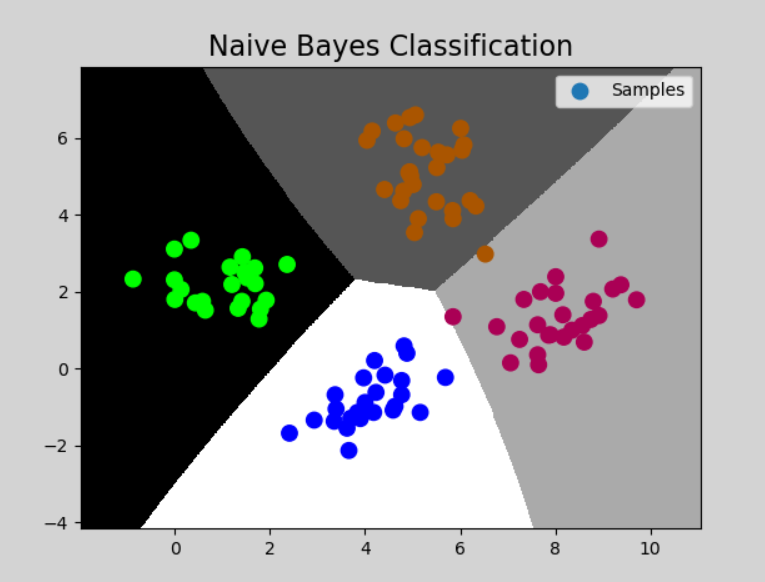| import numpy as np |
| import matplotlib.pyplot as mp |
| import sklearn.naive_bayes as nb |
| import sklearn.model_selection as ms |
| import sklearn.metrics as sm |
| |
| |
| data = np.loadtxt('./multiple1.txt', delimiter=',') |
| x = data[:, :2] |
| y = data[:, -1] |
| print(x.shape, y.shape) |
| |
| |
| train_x, test_x, train_y, test_y = ms.train_test_split(x, y, test_size=0.25, random_state=7) |
| model = nb.GaussianNB() |
| model.fit(train_x, train_y) |
| |
| pred_test_y = model.predict(test_x) |
| |
| |
| cm = sm.confusion_matrix(test_y, pred_test_y) |
| print(cm ,"输出混淆矩阵==========") |
| |
| |
| cr = sm.classification_report(test_y, pred_test_y) |
| print(cr ," 输出分类报告") |
| |
| |
| |
| mp.figure('Naive Bayes Classification', facecolor='lightgray') |
| mp.title('Naive Bayes Classification', fontsize=16) |
| |
| n = 500 |
| l, r = x[:,0].min()-1, x[:,0].max()+1 |
| b, t = x[:,1].min()-1, x[:,1].max()+1 |
| grid_x, grid_y = np.meshgrid(np.linspace(l, r, n), |
| np.linspace(b, t, n)) |
| |
| mesh_x = np.column_stack( (grid_x.ravel(), grid_y.ravel())) |
| grid_z = model.predict(mesh_x) |
| |
| grid_z = grid_z.reshape(grid_x.shape) |
| |
| mp.pcolormesh(grid_x, grid_y, grid_z, cmap='gray') |
| mp.scatter(test_x[:,0], test_x[:,1], s=80, c=test_y, cmap='brg_r', label='Samples') |
| mp.legend() |
| mp.show() |
| (400, 2) (400,) |
| [[22 0 0 0] |
| [ 0 27 1 0] |
| [ 0 0 25 0] |
| [ 0 0 0 25]] 输出混淆矩阵========== |
| precision recall f1-score support |
| |
| 0.0 1.00 1.00 1.00 22 |
| 1.0 1.00 0.96 0.98 28 |
| 2.0 0.96 1.00 0.98 25 |
| 3.0 1.00 1.00 1.00 25 |
| |
| avg / total 0.99 0.99 0.99 100 |
| 输出分类报告 |
- 输出




· 阿里巴巴 QwQ-32B真的超越了 DeepSeek R-1吗?
· 10年+ .NET Coder 心语 ── 封装的思维:从隐藏、稳定开始理解其本质意义
· 【设计模式】告别冗长if-else语句:使用策略模式优化代码结构
· 字符编码:从基础到乱码解决
· 提示词工程——AI应用必不可少的技术